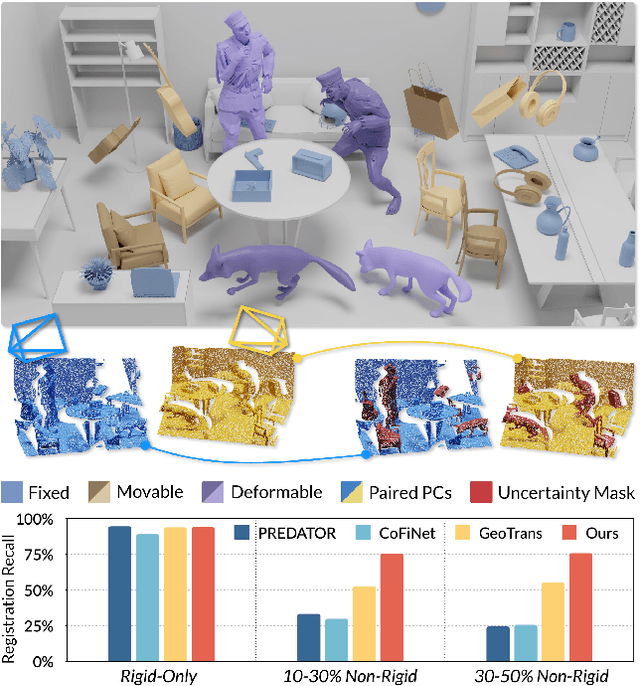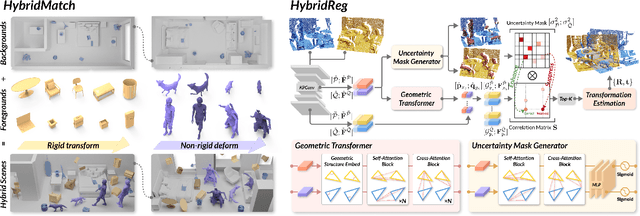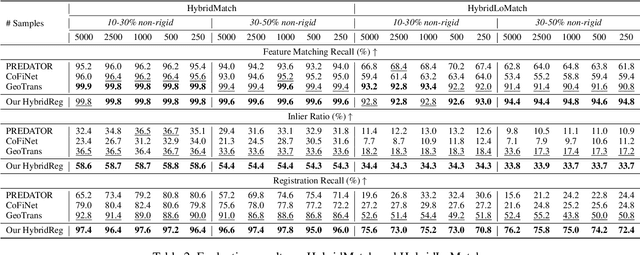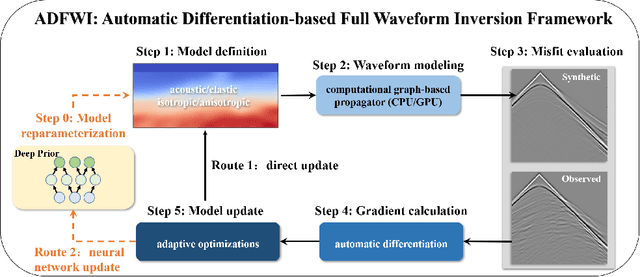Haipeng Li
Blind-Spot Guided Diffusion for Self-supervised Real-World Denoising
Sep 19, 2025Abstract:In this work, we present Blind-Spot Guided Diffusion, a novel self-supervised framework for real-world image denoising. Our approach addresses two major challenges: the limitations of blind-spot networks (BSNs), which often sacrifice local detail and introduce pixel discontinuities due to spatial independence assumptions, and the difficulty of adapting diffusion models to self-supervised denoising. We propose a dual-branch diffusion framework that combines a BSN-based diffusion branch, generating semi-clean images, with a conventional diffusion branch that captures underlying noise distributions. To enable effective training without paired data, we use the BSN-based branch to guide the sampling process, capturing noise structure while preserving local details. Extensive experiments on the SIDD and DND datasets demonstrate state-of-the-art performance, establishing our method as a highly effective self-supervised solution for real-world denoising. Code and pre-trained models are released at: https://github.com/Sumching/BSGD.
Estimating 2D Camera Motion with Hybrid Motion Basis
Jul 30, 2025Abstract:Estimating 2D camera motion is a fundamental computer vision task that models the projection of 3D camera movements onto the 2D image plane. Current methods rely on either homography-based approaches, limited to planar scenes, or meshflow techniques that use grid-based local homographies but struggle with complex non-linear transformations. A key insight of our work is that combining flow fields from different homographies creates motion patterns that cannot be represented by any single homography. We introduce CamFlow, a novel framework that represents camera motion using hybrid motion bases: physical bases derived from camera geometry and stochastic bases for complex scenarios. Our approach includes a hybrid probabilistic loss function based on the Laplace distribution that enhances training robustness. For evaluation, we create a new benchmark by masking dynamic objects in existing optical flow datasets to isolate pure camera motion. Experiments show CamFlow outperforms state-of-the-art methods across diverse scenarios, demonstrating superior robustness and generalization in zero-shot settings. Code and datasets are available at our project page: https://lhaippp.github.io/CamFlow/.
RecCoT: Enhancing Recommendation via Chain-of-Thought
Jun 26, 2025Abstract:In real-world applications, users always interact with items in multiple aspects, such as through implicit binary feedback (e.g., clicks, dislikes, long views) and explicit feedback (e.g., comments, reviews). Modern recommendation systems (RecSys) learn user-item collaborative signals from these implicit feedback signals as a large-scale binary data-streaming, subsequently recommending other highly similar items based on users' personalized historical interactions. However, from this collaborative-connection perspective, the RecSys does not focus on the actual content of the items themselves but instead prioritizes higher-probability signals of behavioral co-occurrence among items. Consequently, under this binary learning paradigm, the RecSys struggles to understand why a user likes or dislikes certain items. To alleviate it, some works attempt to utilize the content-based reviews to capture the semantic knowledge to enhance recommender models. However, most of these methods focus on predicting the ratings of reviews, but do not provide a human-understandable explanation.
StableMotion: Repurposing Diffusion-Based Image Priors for Motion Estimation
May 10, 2025Abstract:We present StableMotion, a novel framework leverages knowledge (geometry and content priors) from pretrained large-scale image diffusion models to perform motion estimation, solving single-image-based image rectification tasks such as Stitched Image Rectangling (SIR) and Rolling Shutter Correction (RSC). Specifically, StableMotion framework takes text-to-image Stable Diffusion (SD) models as backbone and repurposes it into an image-to-motion estimator. To mitigate inconsistent output produced by diffusion models, we propose Adaptive Ensemble Strategy (AES) that consolidates multiple outputs into a cohesive, high-fidelity result. Additionally, we present the concept of Sampling Steps Disaster (SSD), the counterintuitive scenario where increasing the number of sampling steps can lead to poorer outcomes, which enables our framework to achieve one-step inference. StableMotion is verified on two image rectification tasks and delivers state-of-the-art performance in both, as well as showing strong generalizability. Supported by SSD, StableMotion offers a speedup of 200 times compared to previous diffusion model-based methods.
CodingHomo: Bootstrapping Deep Homography With Video Coding
Apr 16, 2025Abstract:Homography estimation is a fundamental task in computer vision with applications in diverse fields. Recent advances in deep learning have improved homography estimation, particularly with unsupervised learning approaches, offering increased robustness and generalizability. However, accurately predicting homography, especially in complex motions, remains a challenge. In response, this work introduces a novel method leveraging video coding, particularly by harnessing inherent motion vectors (MVs) present in videos. We present CodingHomo, an unsupervised framework for homography estimation. Our framework features a Mask-Guided Fusion (MGF) module that identifies and utilizes beneficial features among the MVs, thereby enhancing the accuracy of homography prediction. Additionally, the Mask-Guided Homography Estimation (MGHE) module is presented for eliminating undesired features in the coarse-to-fine homography refinement process. CodingHomo outperforms existing state-of-the-art unsupervised methods, delivering good robustness and generalizability. The code and dataset are available at: \href{github}{https://github.com/liuyike422/CodingHomo
Coding-Prior Guided Diffusion Network for Video Deblurring
Apr 16, 2025Abstract:While recent video deblurring methods have advanced significantly, they often overlook two valuable prior information: (1) motion vectors (MVs) and coding residuals (CRs) from video codecs, which provide efficient inter-frame alignment cues, and (2) the rich real-world knowledge embedded in pre-trained diffusion generative models. We present CPGDNet, a novel two-stage framework that effectively leverages both coding priors and generative diffusion priors for high-quality deblurring. First, our coding-prior feature propagation (CPFP) module utilizes MVs for efficient frame alignment and CRs to generate attention masks, addressing motion inaccuracies and texture variations. Second, a coding-prior controlled generation (CPC) module network integrates coding priors into a pretrained diffusion model, guiding it to enhance critical regions and synthesize realistic details. Experiments demonstrate our method achieves state-of-the-art perceptual quality with up to 30% improvement in IQA metrics. Both the code and the codingprior-augmented dataset will be open-sourced.
Synthetic-to-Real Self-supervised Robust Depth Estimation via Learning with Motion and Structure Priors
Mar 26, 2025Abstract:Self-supervised depth estimation from monocular cameras in diverse outdoor conditions, such as daytime, rain, and nighttime, is challenging due to the difficulty of learning universal representations and the severe lack of labeled real-world adverse data. Previous methods either rely on synthetic inputs and pseudo-depth labels or directly apply daytime strategies to adverse conditions, resulting in suboptimal results. In this paper, we present the first synthetic-to-real robust depth estimation framework, incorporating motion and structure priors to capture real-world knowledge effectively. In the synthetic adaptation, we transfer motion-structure knowledge inside cost volumes for better robust representation, using a frozen daytime model to train a depth estimator in synthetic adverse conditions. In the innovative real adaptation, which targets to fix synthetic-real gaps, models trained earlier identify the weather-insensitive regions with a designed consistency-reweighting strategy to emphasize valid pseudo-labels. We introduce a new regularization by gathering explicit depth distributions to constrain the model when facing real-world data. Experiments show that our method outperforms the state-of-the-art across diverse conditions in multi-frame and single-frame evaluations. We achieve improvements of 7.5% and 4.3% in AbsRel and RMSE on average for nuScenes and Robotcar datasets (daytime, nighttime, rain). In zero-shot evaluation of DrivingStereo (rain, fog), our method generalizes better than the previous ones.
HybridReg: Robust 3D Point Cloud Registration with Hybrid Motions
Mar 10, 2025



Abstract:Scene-level point cloud registration is very challenging when considering dynamic foregrounds. Existing indoor datasets mostly assume rigid motions, so the trained models cannot robustly handle scenes with non-rigid motions. On the other hand, non-rigid datasets are mainly object-level, so the trained models cannot generalize well to complex scenes. This paper presents HybridReg, a new approach to 3D point cloud registration, learning uncertainty mask to account for hybrid motions: rigid for backgrounds and non-rigid/rigid for instance-level foregrounds. First, we build a scene-level 3D registration dataset, namely HybridMatch, designed specifically with strategies to arrange diverse deforming foregrounds in a controllable manner. Second, we account for different motion types and formulate a mask-learning module to alleviate the interference of deforming outliers. Third, we exploit a simple yet effective negative log-likelihood loss to adopt uncertainty to guide the feature extraction and correlation computation. To our best knowledge, HybridReg is the first work that exploits hybrid motions for robust point cloud registration. Extensive experiments show HybridReg's strengths, leading it to achieve state-of-the-art performance on both widely-used indoor and outdoor datasets.
Automatic Differentiation-based Full Waveform Inversion with Flexible Workflows
Nov 30, 2024



Abstract:Full waveform inversion (FWI) is able to construct high-resolution subsurface models by iteratively minimizing discrepancies between observed and simulated seismic data. However, its implementation can be rather involved for complex wave equations, objective functions, or regularization. Recently, automatic differentiation (AD) has proven to be effective in simplifying solutions of various inverse problems, including FWI. In this study, we present an open-source AD-based FWI framework (ADFWI), which is designed to simplify the design, development, and evaluation of novel approaches in FWI with flexibility. The AD-based framework not only includes forword modeling and associated gradient computations for wave equations in various types of media from isotropic acoustic to vertically or horizontally transverse isotropic elastic, but also incorporates a suite of objective functions, regularization techniques, and optimization algorithms. By leveraging state-of-the-art AD, objective functions such as soft dynamic time warping and Wasserstein distance, which are difficult to apply in traditional FWI are also easily integrated into ADFWI. In addition, ADFWI is integrated with deep learning for implicit model reparameterization via neural networks, which not only introduces learned regularization but also allows rapid estimation of uncertainty through dropout. To manage high memory demands in large-scale inversion associated with AD, the proposed framework adopts strategies such as mini-batch and checkpointing. Through comprehensive evaluations, we demonstrate the novelty, practicality and robustness of ADFWI, which can be used to address challenges in FWI and as a workbench for prompt experiments and the development of new inversion strategies.
Cross-Domain Sequential Recommendation via Neural Process
Oct 17, 2024



Abstract:Cross-Domain Sequential Recommendation (CDSR) is a hot topic in sequence-based user interest modeling, which aims at utilizing a single model to predict the next items for different domains. To tackle the CDSR, many methods are focused on domain overlapped users' behaviors fitting, which heavily relies on the same user's different-domain item sequences collaborating signals to capture the synergy of cross-domain item-item correlation. Indeed, these overlapped users occupy a small fraction of the entire user set only, which introduces a strong assumption that the small group of domain overlapped users is enough to represent all domain user behavior characteristics. However, intuitively, such a suggestion is biased, and the insufficient learning paradigm in non-overlapped users will inevitably limit model performance. Further, it is not trivial to model non-overlapped user behaviors in CDSR because there are no other domain behaviors to collaborate with, which causes the observed single-domain users' behavior sequences to be hard to contribute to cross-domain knowledge mining. Considering such a phenomenon, we raise a challenging and unexplored question: How to unleash the potential of non-overlapped users' behaviors to empower CDSR?
 Add to Chrome
Add to Chrome Add to Firefox
Add to Firefox Add to Edge
Add to Edge